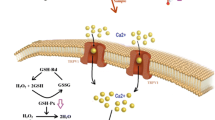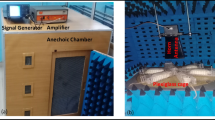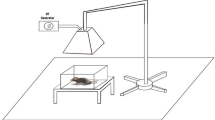Abstract
The present study was designed to determine the effects of both Wi-Fi (2.45 GHz)- and mobile phone (900 and 1800 MHz)-induced electromagnetic radiation (EMR) on oxidative stress and trace element levels in the kidney and testis of growing rats from pregnancy to 6 weeks of age. Thirty-two rats and their 96 newborn offspring were equally divided into four different groups, namely, control, 2.45 GHz, 900 MHz, and 1800 MHz groups. The 2.45 GHz, 900 MHz, and 1,800 MHz groups were exposed to EMR for 60 min/day during pregnancy and growth. During the fourth, fifth, and sixth weeks of the experiment, kidney and testis samples were taken from decapitated rats. Results from the fourth week showed that the level of lipid peroxidation in the kidney and testis and the copper, zinc, reduced glutathione (GSH), glutathione peroxidase (GSH-Px), and total antioxidant status (TAS) values in the kidney decreased in the EMR groups, while iron concentrations in the kidney as well as vitamin A and vitamin E concentrations in the testis increased in the EMR groups. Results for fifth-week samples showed that iron, vitamin A, and β-carotene concentrations in the kidney increased in the EMR groups, while the GSH and TAS levels decreased. The sixth week results showed that iron concentrations in the kidney and the extent of lipid peroxidation in the kidney and testis increased in the EMR groups, while copper, TAS, and GSH concentrations decreased. There were no statistically significant differences in kidney chromium, magnesium, and manganese concentrations among the four groups. In conclusion, Wi-Fi- and mobile phone-induced EMR caused oxidative damage by increasing the extent of lipid peroxidation and the iron level, while decreasing total antioxidant status, copper, and GSH values. Wi-Fi- and mobile phone-induced EMR may cause precocious puberty and oxidative kidney and testis injury in growing rats.

Similar content being viewed by others
References
Behari J, Kesari KK (2006) Effects of microwave radiations on reproductive system of male rats. Embryo Talk 1:81–85
Nazıroğlu M, Yuksel M, Özkaya MO, Köse SA (2013) Effects of Wi-Fi and mobile phone on reproductive systems in female and male. J Membr Biol. doi:10.1007/s00232-013-9597-9
Murphy JC, Kaden DA, Warren J, Sivak A (1993) International Commission for Protection Against Environmental Mutagens and Carcinogens. Power frequency electric and magnetic fields: a review of genetic toxicology. Mutat Res 296:221–240
Nazıroğlu M, Tokat S, Demirci S (2012) Role of melatonin on electromagnetic radiation-induced oxidative stress and Ca2+ signaling molecular pathways in breast cancer. J Recept Signal Transduct Res 32:290–297
Türker Y, Nazıroğlu M, Gümral N et al (2011) Selenium and L-Carnitine reduce oxidative stress in the heart of rat induced by 2.45-GHz radiation from wireless devices. Biol Trace Elem Res 143:1640–1650
Nazıroğlu M, Çelik Ö, Özgül C et al (2012) Melatonin modulates wireless devices (2.45 GHz)-induced brain and dorsal root ganglion injury through TRPM2 and voltage gated calcium channels in rat. Physiol Behav 105:683–692
Kim JY, Kim HT, Moon KH, Shin HJ (2007) Longterm exposure of rats to 2.45 GHz electromagnetic field: effects on reproductive function. Korean J Urol 48:1308–1314
Nazıroğlu M (2007) New molecular mechanisms on the activation of TRPM2 channels by oxidative stress and ADP-ribose. Neurochem Res 32:1990–2001
Nazıroğlu M, Karaoğlu A, Orhan Aksoy A (2004) Selenium and high dose vitamin E administration protects cisplatin- induced oxidative damage to renal, liver and lens tissues in rats. Toxicology 195:221–230
Oksay T, Nazıroğlu M, Doğan S, Güzel A, Gümral N, Koşar PA (2013) Protective effects of melatonin against oxidative injury in rat testis induced by wireless (2.45 GHz) devices. Andrologia. doi:10.1111/and.12044
Hogarth C, Griswold MD (2010) The key role of vitamin A in spermatogenesis. J Clin Invest 120:956–962
Nazıroğlu M, Gumral N (2009) Modulator effects of selenium and L- carnitine on wireless devices (2.45 GHz) induced oxidative stress and electroencephalography records in brain of rat. Int J Radiat Biol 85:680–689
Ebisch IM, Thomas CM, Peters WH, Braat DD, Steegers-Theunissen RP (2007) The importance of folate, zinc and antioxidants in the pathogenesis and prevention of subfertility. Hum Reprod 13:163–174
Favier AE (1992) The role of zinc in reproduction. Hormonal mechanism. Biol Trace Elem Res 32:363–382
Fatmi W, Kechrid Z, Nazıroğlu M, Flores-Arce M (2013) Selenium supplementation modulates zinc levels and antioxidant values in blood and tissues of diabetic rats fed zinc-deficient diet. Biol Trace Elem Res 152:243–250
Nazıroğlu M, Özgül C, Küçükayaz M, Çiğ B, Hebeisen S, Bal R (2013) Selenium attenuates calcium ion influx and oxidative stress through voltage gated and TRPM2 cation channels in transfected cells. Basic Clin Pharmacol Toxicol 112(2):96–102
Nazıroğlu M (2009) Role of selenium on calcium signaling and oxidative stress-induced molecular pathways in epilepsy. Neurochem Res 34:2181–2191
Uğuz AC, Nazıroğlu M, Espino J et al (2009) Selenium modulates oxidative stress-induced cell apoptosis in human myeloid HL-60 cells via regulation of caspase-3, -9 and calcium influx. J Membr Biol 232:15–23
Gulczynska E, Gadzinowski J, Wilczynski J, Zylinska L (2006) Prenatal MgSO4 treatment modifies the erythrocyte band 3 in preterm neonates. Pharmacol Res 53:347–352
Nazıroğlu M (2011) TRPM2 cation channels, oxidative stress and neurological diseases: where are we now? Neurochem Res 36:355–366
Nazıroğlu M (2012) Molecular role of catalase on oxidative stress-induced Ca(2+) signaling and TRP cation channel activation in nervous system. J Recept Signal Transduct Res 32:134–141
Çelik MS, Güven K, Akpolat V, et al (2013) Extremely low frequency magnetic field induces manganese accumulation in brain, kidney and liver of rats. Tox Ind Health (in press)
Wathes DC, Abayasekara DR, Aitken RJ (2007) Polyunsaturated fatty acids in male and female reproduction. Biol Reprod 77:190–201
Nazıroğlu M (2003) Enhanced testicular antioxidant capacity in streptozotocin induced diabetic rats: protective role of vitamins C, E and Selenium. Biol Trace Elem Res 94:61–71
Oktem F, Ozguner F, Mollaoglu H et al (2005) Oxidative damage in the kidney induced by 900-MHz-emitted mobile phone: protection by melatonin. Arch Med Res 36:350–355
Atasoy HI, Gunal MY, Atasoy P, Elgun S, Bugdayci G (2013) Immunohistopathologic demonstration of deleterious effects on growing rat testes of radiofrequency waves emitted from conventional Wi-Fi devices. J Pediatr Urol 9:223–229
Meena R, Kumari K, Kumar J, Rajamani P, Verma HN, Kesari KK (2013) Therapeutic approaches of melatonin in microwave radiations-induced oxidative stress-mediated toxicity on male fertility pattern of Wistar rats. Electromagn Biol Med (in press)
Jelodar G, Nazifi S, Akbari A (2013) The prophylactic effect of vitamin C on induced oxidative stress in rat testis following exposure to 900 MHz radio frequency wave generated by a BTS antenna model. Electromagn Biol Med 32:409–416
Ozlem Nisbet H, Nisbet C, Akar A, Cevik M, Karayigit MO (2012) Effects of exposure to electromagnetic field (1.8/0.9 GHz) on testicular function and structure in growing rats. Res Vet Sci 93(2):1001–1005
Nazıroğlu M, Ciğ B, Doğan S, Uğuz AC, Dilek S, Faouzi D (2012) 2.45-Gz wireless devices induce oxidative stress and proliferation through cytosolic Ca(2+) influx in human leukemia cancer cells. Int J Radiat Biol 88(6):449–456
Jin Z, Zong C, Jiang B, Zhou Z, Tong J, Cao Y (2012) The effect of combined exposure of 900 MHz radiofrequency fields and doxorubicin in HL-60 cells. PLoS One 7(9):e46102
Peyman A, Rezazadeh A, Gabriel C (2001) Changes in the dielectric properties of rat tissue as a function of age at microwave frequencies. Phys Med Biol 46:1617–1629
Placer ZA, Cushman L, Johnson BC (1966) Estimation of products of lipid peroxidation (malonyl dialdehyde) in biological fluids. Anal Biochem 16:359–364
Sedlak J, Lindsay RHC (1968) Estimation of total, protein bound and non-protein sulfhydryl groups in tissue with Ellmann's reagent. Anal Biochem 25:192–205
Lawrence RA, Burk RF (1976) Glutathione peroxidase activity in selenium-deficient rat liver. Biochem Biophys Res Commun 71:952–958
Lowry OH, Rosenbrough NJ, Farr AL, Randall RJ (1951) Protein measurement with the Folin phenol reagent. J Biol Chem 193:265–275
Erel O (2004) A novel automated direct measurement method for total antioxidant capacity using a new generation, more stable ABTS radical cation. Clin Biochem 37:277–285
Desai ID (1984) Vitamin E analysis methods for animal tissues. Methods Enzymol 105:138–147
Suzuki J, Katoh N (1990) A simple and cheap method for measuring vitamin A in cattle using only a spectrophotometer. Jpn J Vet Sci 52:1282–1284
Clegg MS, Keen CL, Lönnerdal B, Hurley LS (1981) Influence of ashing techniques in the analyses of trace elements in animal tissue. Biol Trace Elem Res 3:107–115
Kismali G, Ozgur E, Guler G, Akcay A, Sel T, Seyhan N (2012) The influence of 1800 MHz GSM-like signals on blood chemistry and oxidative stress in non-pregnant and pregnant rabbits. Int J Rad Biol 88:414–419
Devrim E, Ergüder IB, Kılıçoğlu B, Yaykaşlı E, Cetin R, Durak I (2008) Effects of electromagnetic radiation use on oxidant/antioxidant status and DNA turn-over enzyme activities in erythrocytes and heart, kidney, liver, and ovary tissues from rats: possible protective role of vitamin C. Toxicol Mech Methods 18:679–683
Nazıroğlu M, Özgül C, Çiğ B (2013) Neuroprotection induced by N-acetylcysteine against cytosolic glutathione depletion induced-Ca2+ influx through TRPV1 channels in dorsal root ganglion neuron of mice. Neuroscience 242:151–160
Zago MP, Oteiza PI (2001) The antioxidant properties of zinc: interactions with iron and antioxidants. Free Radic Biol Med 31:266–274
Pal A, Singh A, Nag TC, Chattopadhyay P, Mathur R, Jain S (2013) Iron oxide nanoparticles and magnetic field exposure promote functional recovery by attenuating free radical-induced damage in rats with spinal cord transection. Int J Nanomedicine 8:2259–2272
Nazıroğlu M, Yürekli VA (2013) Effects of antiepileptic drugs on antioxidant and oxidant molecular pathways: focus on trace elements. Cell Mol Neurosci 33:589–599
Baltaci AK, Mogulkoc R, Salbacak A, Celik I, Sivrikaya A (2012) The role of zinc supplementation in the inhibition of tissue damage caused by exposure to electromagnetic field in rat lung and liver tissues. Bratisl Lek Listy 113:400–403
Author information
Authors and Affiliations
Corresponding author
Rights and permissions
About this article
Cite this article
Özorak, A., Nazıroğlu, M., Çelik, Ö. et al. Wi-Fi (2.45 GHz)- and Mobile Phone (900 and 1800 MHz)-Induced Risks on Oxidative Stress and Elements in Kidney and Testis of Rats During Pregnancy and the Development of Offspring. Biol Trace Elem Res 156, 221–229 (2013). https://doi.org/10.1007/s12011-013-9836-z
Received:
Accepted:
Published:
Issue Date:
DOI: https://doi.org/10.1007/s12011-013-9836-z




